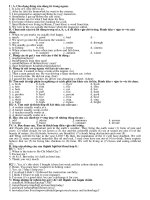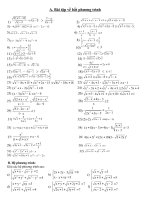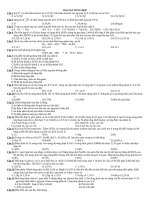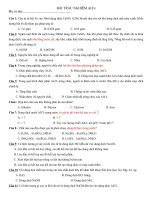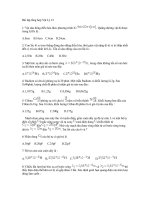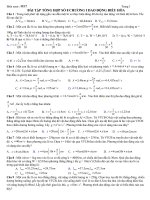Bài tập tổng hợp - C18
Bạn đang xem bản rút gọn của tài liệu. Xem và tải ngay bản đầy đủ của tài liệu tại đây (79.24 KB, 5 trang )
<span class='text_page_counter'>(1)</span><div class='page_container' data-page=1>
Copyright © 2003, American Society for Microbiology. All Rights Reserved.
Duration of Infection and Proportion of Pigs Persistently Infected with
Porcine Reproductive and Respiratory Syndrome Virus†
Robert W. Wills,* Alan R. Doster, Judith A. Galeota, Jung-Hyang Sur,‡ and Fernando A. Osorio
<i>Department of Veterinary and Biomedical Science, University of Nebraska—Lincoln, Lincoln, Nebraska 68583-0907</i>
Received 4 April 2002/Returned for modification 2 September 2002/Accepted 13 October 2002
<b>Understanding the dynamics of porcine reproductive and respiratory syndrome virus (PRRSV) persistence</b>
<b>in individual pigs is essential to the development of successful control programs. The objectives of this study</b>
<b>were to investigate the proportion of inoculated pigs that become persistently infected with PRRSV and the</b>
<b>duration of their infection. Additionally, different diagnostic techniques that detect persistent infections were</b>
<b>compared. Twenty-eight 35-day-old pigs were inoculated with PRRSV. Serum and tonsil biopsy samples were</b>
<b>collected on days 0, 7, 14, and 28 and then approximately monthly thereafter until day 251 postinoculation</b>
<b>(p.i.). Tonsil, lymph node, and lung samples were collected following euthanasia on day 251 p.i. Virus was</b>
<b>isolated from serum and tonsil biopsy samples that had been collected through days 28 and 56 p.i., respectively.</b>
<b>Viral RNA was detected by reverse transcription (RT)-PCR in serum and tonsil biopsy samples that had been</b>
<b>collected through day 251 p.i., although no serum samples collected from days 84 to 196 p.i. were positive and</b>
<b>the presence of infectious PRRSV was not detected by swine bioassay of tissue samples collected at necropsy.</b>
<b>The results confirmed that RT-PCR is more sensitive than virus isolation in identifying PRRSV-infected pigs.</b>
<b>Six pigs that were persistently infected through days 225 or 251 p.i. remained seropositive throughout the</b>
<b>study, although one pig had an enzyme-linked immunosorbent assay sample-to-positive ratio that was only</b>
<b>slightly above the cutoff value of 0.40. Twenty of 28 tonsil biopsy samples collected on day 84 p.i. were positive</b>
<b>by RT-PCR compared to only 1 positive biopsy sample out of 28 collected on day 119 p.i. The study’s results</b>
<b>indicate that most pigs clear PRRSV within 3 to 4 months, but that some may remain persistently infected for</b>
<b>several months.</b>
Porcine reproductive and respiratory syndrome virus
(PRRSV) causes a potentially devastating disease in swine
herds. Understanding the dynamics of PRRSV persistence and
transmission is essential to the development of successful
pre-vention programs. Research has documented PRRSV
trans-mission between pigs in direct contact and allowed
investiga-tion of the durainvestiga-tion of infecinvestiga-tion. Early transmission studies
demonstrated that pigs were persistently infected and capable
of transmitting virus 56 (8) and 99 (11) days after initial
inoc-ulation. The use of a convalescent, asymptomatic sow in the
latter study illustrated the potential of recovered animals to be
the source of infection to naăve herds. The offspring of
PRRSV-inoculated sows were shown to transmit virus
follow-ing treatment with immunosuppressive doses of prednisolone
acetate at 154 days of age (1). Wills et al. provided direct
evidence of persistent PRRSV infection in a study in which
PRRSV was recovered from oropharyngeal scrapings up to 157
days postinoculation (p.i.) (9). Benfield et al. isolated virus
from the tonsils of piglets up to 130 days after birth from sows
inoculated at 85 to 90 days of gestation (4). In the same study,
viral RNA was detected in the serum of one pig at 210 days
after birth.
Field observations of closed herds infected with PRRSV for
long periods of time and instances of transmission via
intro-duction of clinically normal, but PRRSV-infected, animals,
into naïve herds highlight the importance of characterizing the
persistence of PRRSV infection. The proportion of
persis-tently infected animals also directly affects the dynamics of
virus transmission within a herd. Since a persistently infected
animal is a potential source of infection, the ability to estimate
the proportion of persistently infected animals is of critical
importance in developing strategies for prevention and control
programs. Producers are often faced with the decision of
whether to introduce previously infected animals into their
herds. Currently, it is not clear if pigs that have returned to
seronegative status following initial seroconversion are still
capable of harboring PRRSV.
The objectives of this study were to investigate the
propor-tion of inoculated pigs that become persistently infected with
PRRSV and the duration of their infection. Additionally, this
study compared different diagnostic techniques that allow
de-tection of persistent infections.
<b>MATERIALS AND METHODS</b>
<b>Virus.</b>The PRRSV isolate (16244B) used in this experiment has been
previ-ously described (3). Briefly, the virus was originally derived from the serum of a
7-day-old clinically affected pig from a breeding herd that was experiencing a
severe outbreak of porcine reproductive and respiratory syndrome. The virus was
propagated twice in the MARC-145 cell line (7) at 37°C. The titer of the virus
inoculum used in the study was determined by a microtiter assay of the same cell
line.
<b>Experimental animals.</b>Fifty 10- to 14-day-old segregated, early weaned,
fe-male pigs were obtained from a herd that was periodically tested for PRRSV
antibodies by enzyme-linked immunosorbent assay (ELISA) (HerdChek
PRRSV: IDEXX Laboratories, Westbrook, Maine) and known to be free from
* Corresponding author. Present address: P.O. Box 6100, Mississippi
State, MS 39762. Phone: (662) 325-9718. Fax: (662) 325-1031. E-mail:
† Publication 13,849 of the Agricultural Research Division of the
University of Nebraska—Lincoln.
‡ Present address: Plum Island Animal Disease Center, Greenport,
NY 11944.
</div>
<span class='text_page_counter'>(2)</span><div class='page_container' data-page=2>
PRRSV infection. The pigs were held in isolation rooms, acclimated to their
surroundings for 17 days, and then randomly assigned to one of five isolation
rooms according to treatment group. The pigs in four of the rooms were
desig-nated principals, while the pigs in the fifth group were desigdesig-nated negative
controls. Five days later, when the pigs were approximately 35 days of age, serum
samples were collected from the pigs. The pigs designated principals were
inoc-ulated intranasally with 2 ml of inoculum containing approximately 106<sub>50%</sub>
tissue culture infective doses of PRRSV isolate 16244B, divided between both
nostrils. The negative controls were not inoculated with virus. Three pigs in each
room were randomly assigned to another research study (2). They were treated
the same as the other pigs in the rooms until 150 days p.i., at which time they
were removed. Only information collected for the remaining 35 pigs is presented
in this paper. The use of animals in this research project followed protocols
approved by the Institutional Animal Care and Use Committee of the University
of Nebraska—Lincoln and complied with all relevant federal guidelines.
<b>Sample collection.</b>Jugular or anterior vena cava blood samples were collected
with blood collection tubes (Vacutainer; Becton Dickinson, Franklin Lakes, N.J.)
on days 0, 7, 14, and 28 and then approximately monthly thereafter until day
225 p.i. After the blood samples were collected, the pigs were given an
intrave-nous injection of an anesthetic cocktail that was made by reconstituting 250 mg
of tiletamine and 250 mg of zolazepam (Telazol; Fort Dodge Animal Health,
Fort Dodge, Iowa) with 12.5 ml of xylazine (100 mg/ml) and 12.5 ml of ketamine
(100 mg/ml) (Ketaset; Fort Dodge Animal Health). The cocktail was
adminis-tered at a dosage of 0.15 ml/10 lb of body weight. After the pigs were
anesthe-tized, a 4.0-mm-diameter dermatology biopsy punch was used to harvest an
approximately 4.0- by 8.0-mm section of tissue from each palatine tonsil.
Imme-diately upon collection, one tonsil biopsy sample was placed in a sterile 1.5-ml
Eppendorf tube on dry ice and stored at⫺70°C. The second biopsy sample, if
collected on days 0 to 119 p.i., was placed in 0.5 ml of 10% buffered formalin. If
collected on days 147 to 225 p.i., the second biopsy sample was placed on dry ice
and stored at⫺70°C. On day 251 p.i., all inoculated pigs and one randomly
selected control pig were euthanized. Blood, tonsil, bronchial lymph node,
spleen, and lung samples were collected at necropsy. Portions of the tissue
samples were placed in 10% buffered formalin. Other aliquots were frozen at
⫺70°C. Blood samples were collected from the remaining six control pigs the
next day (day 252 p.i.). Serum harvested from blood samples was aliquoted into
1.5-ml Eppendorf tubes. Serum samples were tested by using a commercial
PRRSV ELISA (HerdChek PRRSV; IDEXX Laboratories). Serum was also
stored at⫺70°C for later analysis.
<b>Virus isolation.</b>Virus isolation on MARC-145 cells was conducted with serum
and tonsil biopsy samples collected from the principals and a negative control pig
randomly selected for a given collection day. Virus isolation was conducted with
serum collected on days 7 to 84 p.i. and with tonsil homogenates prepared from
biopsy samples or necropsy tissues collected on days 7 to 251 p.i. In each case,
samples collected on the same day were assayed as a group. Tonsil homogenates
were made by grinding the tissue with a pestle in an Eppendorf tube, adding 500
l of minimal essential medium (MEM) with 50g of gentamicin per ml and
vortexing with the pestle in the tube. The pestle was removed, an additional 500
l of MEM was added, and the mixture was vortexed. The suspension was then
passed through a 0.20-m-pore-size filter and divided into two aliquots. One
aliquot was used for virus isolation. The other aliquot of each tonsil homogenate
from days 7 to 251 p.i. was reserved for analysis by nested reverse transcription
(RT)-PCR.
Monolayers of 2- to 3-day-old MARC-145 cells in 12- or 24-well plates were
used in virus isolation. The cells were inoculated with either 300l of serum or
150l of tonsil homogenate plus 150l of MEM with 50g of gentamicin per
ml and incubated for 1 h at 37°C with 5% CO2. The media were removed by
pipette and then replaced with 1 ml of MEM with 50g of gentamicin per ml.
The cells were incubated for 7 days at 37°C with 5% CO2and checked daily for
signs of cytopathic effects (CPE). If CPE were observed or the 7 days had
elapsed, the plates were frozen and thawed. Two hundred microliters of the
supernatant was used to inoculate 2- to 3-day-old MARC-145 cells. The
proce-dure for the first passage was duplicated. At the end of the 7-day incubation
period or if CPE were seen sooner, the cells were fixed with acetone-methanol
and stained with the PRRSV fluorescent monoclonal antibody conjugate
SDOW17 (David Benfield, South Dakota State University, Brookings, S.Dak.).
<b>RT-PCR.</b>Aliquots of the tonsil homogenates prepared as inoculum for the
virus isolation assay were analyzed by RT-PCR. Separate tonsil biopsy samples
collected on days 147 to 225 p.i. and tonsillar tissue collected at necropsy were
prepared specifically for RT-PCR analysis. In this case, the RNA extraction
process was conducted directly on ground tonsillar tissue, not on tonsillar tissue
mixed with MEM. The presence of viral RNA was also assessed by RT-PCR with
serum samples collected on days 0 to 251. Samples that were collected on the
same day were assayed as a group, with the exception of the serum samples
collected from control pigs on day 252 p.i., which were analyzed with the samples
collected on day 251 p.i.
Viral RNA was extracted by first adding 0.75 ml of Trizol (Gibco BRL,
Gaithersburg, Md.) to 0.25 ml of serum, 0.25 ml of inoculum prepared for virus
isolation from tonsil tissues, or directly to ground tonsillar tissue. A known
PRRSV-positive serum sample and a PRRSV-negative fetal calf serum sample
were included as positive and negative controls. After incubation at room
tem-perature for 5 min, 0.2 ml of chloroform was added to each sample, which were
shaken vigorously for 15 s, incubated for 15 min at room temperature, and then
centrifuged at 10,000⫻<i>g</i>for 15 min at 4°C. The supernatant was removed and
added to tubes containing 2l of glycogen. After 0.5 ml of isopropanol was
added, the contents of the tubes were mixed and incubated at room temperature
for 10 min. Following centrifugation at 10,000 ⫻<i>g</i> for 10 min at 4°C, the
isopropanol was drained, leaving a pellet that was then rinsed with 1 ml of 75%
ethanol–25% diethyl pyrocarbonate water and allowed to dry. The RNA pellet
was then dissolved in 20l of diethyl pyrocarbonate water. RT-PCR was
per-formed by using an EZ rTth RNA PCR kit (Perkin-Elmer, Branchburg, N.J.) and
was followed by nested PCR, both using primers which amplify open reading
frame 6 of PRRSV. These primers included 14424 F (5⬘AGGTGCTCTTGGC
GTTCTCTATT 3⬘) and 14836 R (5⬘GCTTTTCTGCCACCCAACACG 3⬘) for
outer PCR and 14661 F (5⬘CCTCCAGATGCCGTTTGTGCT 3⬘) and 14790 R
(5⬘TGCCGTTGACCGTAGTGGAGC 3⬘) for nested PCR.
Each reaction was performed in a final volume of 50l containing 4 mM Mn2⫹
(for the RT), a 0.3 mM concentration of each deoxynucleoside triphosphate, a
0.8M concentration of each primer, and 5 U of a recombinant<i>Tth</i>polymerase.
The samples were then placed in a thermocycler for 30 min at 60°C and then for
3 min at 95°C, followed by 35 cycles consisting of 1 min of denaturation at 95°C,
1 min of primer annealing at 60°C, and 1 min of extension at 72°C. For the nested
PCR, 2-l aliquots of products from the previous RT-PCR were added to tubes
containing 1 mM Mg2⫹<sub>, a 0.2 mM concentration of each deoxynucleoside</sub>
triphosphate, a 0.8M concentration of each primer, and 5 U of<i>Taq</i>
polymer-ase. Cycling parameters for the nested PCR were the same as those for the outer
PCR. The samples were then electrophoresed on 2% Nu-Sieve 3:1 agarose
(FMC BioProducts, Rockland, Maine).
<b>Bioassay.</b>The presence of infectious PRRSV in tissue samples collected at
necropsy from the 28 principals and one control pig was assessed by bioassay.
PRRSV-free sentinel pigs were inoculated with tissue preparations from the
principals and the control pigs and then tested for evidence of infection. Samples
of tonsil, lymph node, and lung tissue were used for pigs 1, 2, 16, 24, 26, 29, 34,
and 40. The procedure was subsequently modified to also include samples of
spleen to potentially improve the detection of virus in the remaining pigs.
Ap-proximately 8 g of each type of tissue was minced and mixed with 15 ml of MEM.
Homogenates were placed in plastic bags and macerated (stomacher; Colworth),
frozen at⫺70°C, thawed, and centrifuged at 1200 ⫻<i>g</i> for 10 min. Eleven
milliliters of supernatant was drawn into a syringe for inoculation of pigs. Serum
samples (0.5 ml) collected from pigs 7, 29, and 40 on days 56, 251, and 225 p.i.,
respectively, were also used but without further processing. Eight 2- to
3-week-old pigs, obtained from a herd known to be PRRSV-free through periodic
serologic testing, were used as sentinels. The pigs were housed in separate
isolation rooms for the remainder of the experiment. For each round of
bioas-says, supernatant or serum from a single pig was injected into the peritoneal
cavity of a sentinel pig. Serum samples were collected from sentinel pigs just
prior to injection and again approximately 14 and 28 days later. Serum samples
were assayed by PRRSV ELISA for the presence of anti-PRRSV antibodies. The
eight recipient pigs remained seronegative and were used repeatedly as sentinels
for all subsequent bioassays.
<b>RESULTS</b>
</div>
<span class='text_page_counter'>(3)</span><div class='page_container' data-page=3>
tonsil preparations used for virus isolation were RT-PCR
pos-itive through day 84 p.i. and then sporadically through day 251
(Table 1). Tonsil biopsy samples prepared specifically for
RT-PCR analysis were all negative on days 147 and 251, and 1
tonsil biopsy sample out of 28 was positive on days 168, 196,
and 225 p.i. (Table 1).
Serum or tonsil samples from nine of the inoculated pigs
were RT-PCR positive at least once on day 119 p.i. or later
(Table 2). The detection of viral RNA by RT-PCR from days
119 to 251 p.i. was sporadic in that viral RNA was detected in
samples from nine different animals during this time, but RNA
was not detected in samples from the same pigs during
con-secutive months. Furthermore, viral RNA was not detected in
both serum and tonsil samples collected on the same day from
any of the pigs.
All principal and control pigs were seronegative (ELISA
sample-to-positive [S/P] ratios of less than 0.40) on day 0 p.i.
The negative-control pigs remained seronegative throughout
the experiment. All inoculated animals seroconverted. Three
pigs returned to seronegative status on or after day 196 p.i.
Virus was not isolated nor was viral RNA detected in these
animals beyond day 119 p.i. The nine pigs that were
persis-tently infected for 119 days or more according to RT-PCR
results did not return to seronegative status by the end of the
trial, although the S/P ratio for pig 1 was 0.41 on day 251 p.i.
(Fig. 1). The aliquot of the tonsil homogenate prepared for
virus isolation from this pig was positive by virus isolation up to
day 28 p.i. and by RT-PCR on days 28 and 225 p.i.
The bioassay pigs were seronegative prior to the initial
in-jection and remained so after repeated intraperitoneal
injec-tions. These results indicated that there was no infectious virus
in the sera or tested tissue samples from day 251 p.i.
<b>DISCUSSION</b>
There appears to be a growing body of evidence suggesting
that changes affecting persistence occur around 3 or 4 months
after initial infection. In the present study, there was an abrupt
drop in the proportion of pigs with RT-PCR-positive tonsil
samples from 71% on day 84 to 4% on day 119 p.i. Other
investigators have demonstrated that a high proportion (90%)
of inoculated pigs remain infected with virus through day
105 p.i. at least (6). The results of the present study also
corroborate earlier work in which PRRSV was isolated from
oropharyngeal scrapings collected from three out of four pigs
on day 84 p.i., but the virus was isolated from, at most, one out
of four samples collected on days 98, 115, 128, 143, and 157 p.i.
(9). Similarly, in a study which used same-room cohorts of the
pigs in the present study, Allende et al. reported that 5 out of
10 inoculated pigs were persistently infected at 84 days p.i. and
that 2 out of 10 were infected on day 150 p.i. (2). Collectively,
the results demonstrate that although pigs can remain
persis-tently infected for several months, there is a distinct drop in the
proportion of animals harboring the virus that suggests that
most pigs clear the virus between 3 and 4 months after
infec-tion. The study does not rule out—and, in fact, it may
sug-gest—that very low levels of replication may occur in individual
animals and may allow sporadic detection of viral RNA.
Recent research (6) has indicated that the diagnostic
sensi-tivity of RT-PCR analysis of oropharyngeal scrapings is greater
than that of tonsil homogenates, which were used in the
present study. Consequently, some variation between reports
in the proportions of pigs and the lengths of time that they
harbor PRRSV is to be expected. Perhaps, if oropharyngeal
scrapings instead of tonsil biopsy samples had been used in the
present study, PRRSV would have been detected in a greater
proportion of pigs for a longer period of time.
Greater proportions of serum and tonsil biopsy samples
from days 28 and 56 were found to be PRRSV RNA positive
by RT-PCR than by virus isolation. These results confirm that
RT-PCR is more sensitive than virus isolation in identifying
PRRSV-infected pigs. It should be noted that positive
RT-PCR results do not necessarily indicate the presence of viable
virus, only the presence of viral RNA. At the same time, it
appears likely that in order for viral RNA to be detected up to
day 251 p.i., replicating virus must also be present for extended
periods of time. This was supported by concurrent research in
which the bioassay of pigs demonstrated the presence of viable
TABLE 1. Detection of PRRSV from serum and
tonsil tissue samples
Day p.i.
Virus isolation<i>a</i> <sub>RT-PCR</sub><i>b</i>
Serum Tonsil biopsy<sub>sample</sub> Serum <sub>inoculum</sub>Tonsil VI<i>c</i> Tonsil biopsy<sub>sample</sub>
7
28/28
26/28
27/28
27/28
NT
<i>d</i>14
20/28
23/28
28/28
28/28
NT
28
2/28
9/28
7/28
27/28
NT
56
0/28
4/28
1/28
21/28
NT
84
0/28
0/28
0/28
20/28
NT
119
NT
0/28
0/28
1/28
NT
147
NT
0/28
0/28
2/28
0/28
168
NT
0/28
0/28
0/28
1/28
196
NT
0/28
0/28
0/28
1/28
225
NT
0/28
1/28
1/28
1/28
251
<i>e</i><sub>NT</sub>
<sub>0/28</sub>
<sub>1/28</sub>
<sub>2/28</sub>
<sub>0/28</sub>
<i>a</i><sub>Values are numbers of serum or tonsil biopsy samples from which PRRSV</sub>
was isolated relative to numbers tested.
<i>b</i><sub>Values are numbers of serum or tonsil samples positive for PRRSV RNA</sub>
relative to numbers tested by RT-PCR.
<i>c</i><sub>Tonsil VI inoculum, aliquot of tonsil preparation used for virus isolation.</sub>
<i>d</i><sub>NT, not tested.</sub>
<i>e</i><sub>Samples collected on day 251 p.i. were at necropsy.</sub>
TABLE 2. RT-PCR results for pigs in which viral RNA was
detected on day 119 p.i. or later
Pig RT-PCR result
<i>a</i><sub>on indicated day p.i.</sub>
7 14 28 56 84 119 147 168 196 225 251
1
A, S
A, S A
A
2
A
A, S A
A
A
A
16
A, S
A, S A
A
A
A
B
24
A, S
A, S A, S
A
A
25
A, S
A, S
A
A
B
B
26
A, S
A, S A, S
A
A
A
29
S
A, S A
A
S
34
A, S
A, S A
A
A
40
A, S
A, S A
A
S
<i>a</i><sub>A, viral RNA detected in inoculum of tonsil virus isolation assay by RT-PCR;</sub>
</div>
<span class='text_page_counter'>(4)</span><div class='page_container' data-page=4>
virus in tissue samples collected from pigs inoculated 5 months
previously (2).
PRRSV infection was cleared by day 251 p.i., as evidenced
by negative bioassay results for tissue samples collected at
necropsy. However, viral RNA was detected in tonsil samples
collected from two pigs on day 251 p.i. Negative bioassay
re-sults were also obtained for three serum samples collected on
days 56, 225, and 251 p.i. that tested positive for viral RNA by
RT-PCR. The sporadic detection of positive results for viral
RNA in serum after months of negative samples has been
reported previously (4). Although it is possible that the
obser-vation of sporadic positive samples is due to false-positive
reactions, 177 tonsil and serum samples collected from the
seven negative-control pigs were negative by RT-PCR. If we
assume that the RT-PCR results for the three serum samples
and the two tonsil samples were truly positive, the apparent
discrepancy between the RT-PCR and bioassay results would
indicate that the bioassay is less sensitive than RT-PCR. In a
study comparing bioassay and RT-PCR assay of boar semen
samples, the bioassay detected the presence of virus in 63 of 67
RT-PCR-positive samples, reaffirming that RT-PCR may be
more sensitive than bioassay (5). The infectious dose of
PRRSV has been estimated to be less than 20 virions when
inoculation is by the intranasal or intramuscular route (10).
Consequently, bioassay would be expected to be an extremely
sensitive test, but a greater infectious dose may be required
when pigs are inoculated via the intraperitoneal route.
Alter-natively, the discrepancy could be explained by the persistence
of viral RNA in the absence of viable virus. This is unlikely in
that evidence supporting the persistence of RNA has not been
previously reported.
With the exception of the data for pig 1, the results suggest
that an animal that has returned to seronegative status is
un-likely to harbor the virus. The results for pig 1 suggest that viral
RNA may still be detected in pigs with an S/P ratio of less than,
or at least near, the cutoff value of 0.40. This finding has
significant impact on the use of ELISA for the identification of
PRRSV-infected animals. Pigs which have returned to
sero-negative status based on PRRSV ELISA results may still
har-bor PRRSV and be a source of virus for susceptible animals. A
lower reference point might be indicated when the PRRSV
ELISA is used for test and removal strategies. Additional
re-search is needed to better determine the length of time during
which pigs remain contagious to susceptible pigs.
<b>ACKNOWLEDGMENTS</b>
We thank Blaine Clowser, Jennifer Friesen, Eric Mousel, and
Ros-sana Allende for their technical assistance and input.
This research was partially funded by the Nebraska Pork Producers
Association and the National Pork Producers Council in association
with the National Pork Board. This research was also supported by
USDA National Research Initiative Competitive Grant Program
Project no. 99-35204-8041.
<b>REFERENCES</b>
1. <b>Albina, E., F. Madec, R. Cariolet, and J. Torrison.</b>1994. Immune response
and persistence of the porcine reproductive and respiratory syndrome virus
in infected pigs and farm units. Vet. Rec.<b>134:</b>567–573.
2. <b>Allende, R., W. W. Laegreid, G. F. Kutish, J. A. Galeota, R. W. Wills, and</b>
<b>F. A. Osorio.</b>2000. Porcine reproductive and respiratory syndrome virus: a
description of persistence in individual pigs upon experimental infection.
J. Virol.<b>74:</b>10834–10837.
3. <b>Allende, R., T. L. Lewis, Z. Lu, D. L. Rock, G. F. Kutish, A. Ali, A. R. Doster,</b>
<b>and F. A. Osorio.</b>1999. North American and European porcine reproductive
and respiratory syndrome viruses differ in nonstructural protein coding
re-gions. J. Gen. Virol.<b>80:</b>307–315.
</div>
<span class='text_page_counter'>(5)</span><div class='page_container' data-page=5>
455–458.<i>In</i>Proceedings of the American Association of Swine Practitioners.
American Association of Swine Practitioners, Quebec City, Quebec, Canada.
5. <b>Christopher-Hennings, J., E. A. Nelson, J. K. Nelson, R. J. Hines, S. L.</b>
<b>Swenson, H. T. Hill, J. J. Zimmerman, J. B. Katz, M. J. Yaeger, C. C. L.</b>
<b>Chase, and D. A. Benfield.</b>1995. Detection of porcine reproductive and
respiratory syndrome virus in boar semen by PCR. J. Clin. Microbiol.<b>33:</b>
1730–1734.
6. <b>Horter, D. C., R. M. Pogranichniy, C. C. Chang, R. B. Evans, K. J. Yoon, and</b>
<b>J. J. Zimmerman.</b>2002. Characterization of the carrier state in porcine
reproductive and respiratory syndrome virus infection. Vet. Microbiol.<b>86:</b>
213–228.
7. <b>Kim, H. S., J. Kwang, I. J. Yoon, H. S. Joo, and M. L. Frey.</b>1993. Enhanced
replication of porcine reproductive and respiratory syndrome (PRRS) virus
in a homogeneous subpopulation of MA-104 cell line. Arch. Virol.<b>133:</b>477–
483.
8. <b>Terpstra, C., G. Wensvoort, and L. A. M. G. van Leengoed.</b>1992. Persistence
of Lelystad virus in herds affected by porcine epidemic abortion and
respi-ratory syndrome, p. 118.<i>In</i>Proceedings of the International Pig Veterinary
Society. Royal Netherlands Veterinary Society, The Hague, The
Nether-lands.
9. <b>Wills, R. W., J. J. Zimmerman, K. J. Yoon, S. L. Swenson, M. J. McGinley,</b>
<b>H. T. Hill, K. B. Platt, J. C. Hennings, and E. A. Nelson.</b>1997. Porcine
reproductive and respiratory syndrome virus: a persistent infection. Vet.
Microbiol.<b>55:</b>231–240.
10. <b>Yoon, K. J., J. J. Zimmerman, C. C. Chang, S. Cancel Tirado, K. M.</b>
<b>Harmon, and M. J. McGinley.</b>1999. Effect of challenge dose and route on
porcine reproductive and respiratory syndrome virus (PRRSV) infection in
young swine. Vet. Res.<b>30:</b>629–638.
</div>
<!--links-->
